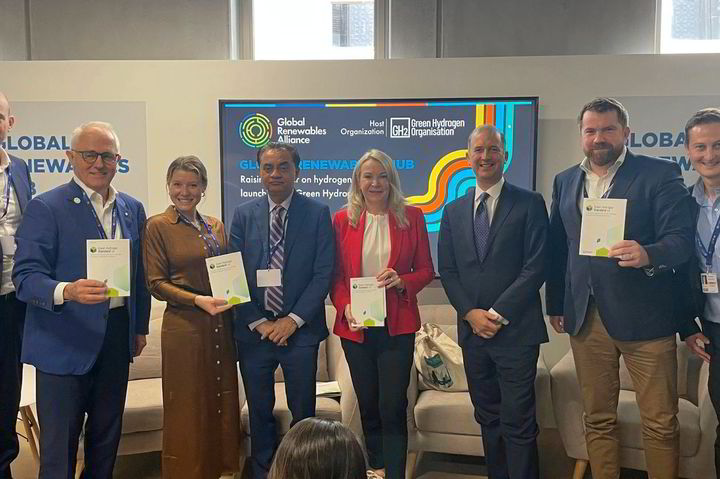Hydrogen at COP28 | Fortescue and TES line up behind beefed-up green H2 standard

Major green hydrogen developers attending the COP28 climate conference in the United Arab Emirates (UAE) such as Fortescue and TES have lined up in support of a beefed-up version of a green hydrogen standard launched over the weekend that significantly bolsters the emissions and sustainability requirements on producers of renewable H2.
The new “Green Hydrogen Standard 2.0” is an expansion of the initial iteration, launched by the Switzerland-based Green Hydrogen Organisation (GH2), in May last year, which has been updated to include renewable H2 derivatives such as green ammonia, green methanol and synthetic methane for the first time.
GH2, which ultimately hopes the voluntary protocols will become the global standard for green hydrogen and its derivatives, aims to bolster the sector’s climate credentials and prevent greenwashing.
The new protocols for green ammonia and methanol demand “well-to-gate” emissions intensity of 3kg of CO2-equivalent per kg of ammonia or methanol, while the protocol for e-methane demands emissions intensity of 0.85kg of CO2-equivalent per kg of methane.
GH2 has also introduced a new expectation on developers to demonstrate a plan to mitigate emissions of hydrogen, which is an indirect greenhouse gas, as well as new rules for H2 made with from biomass-fired power stations.
In addition, the Green Hydrogen Standard 2.0 includes provision to smooth producers’ path to subsidy access with a new accreditation procedure that will allow producers to opt in to demonstrate compliance with the EU’s Delegated Act rules, forthcoming US Treasury rules and the existing GHS’s emissions threshold of 1kg CO2-equivalent per kg of H2 produced.
Article continues below the advert
From 2027, the EU will demand the use of additional renewables capacity and matched electrolyser operation measured across a month.
“We must be clear on which hydrogen production pathways are 1.5°C-aligned and which are not,” said chair of the Green Hydrogen Organisation and former Australian prime minister Malcolm Turnbull. “Standards without [lifetime emissions] thresholds legitimise hydrogen projects that are not sustainable. The updated Green Hydrogen Standard 2.0 which now extends to new hydrogen derivatives will ensure that green hydrogen is truly clean and has a positive development impact.”
Meanwhile, some big names in the renewable H2 industry have indicated that they would adopt the stringent standards included in the Green Hydrogen Standard 2.0.
Mark Hutchinson, CEO of mining giant Fortescue’s energy division, said: “Fortescue is committed to the production of green hydrogen with zero carbon emissions and strong sustainability criteria. The Green Hydrogen Standard sets a benchmark for what can be considered GH2 Green Hydrogen, and we plan to implement it across our global portfolio of green hydrogen projects.”
Green e-methane developer TES also endorsed the standard, with CEO Marco Alvera emphasising the role that it will play in commoditising green fuels.
“The standard is a crucial step towards building confidence and transparency within the market, establishing e-NG [synthetic natural gas made using electricity and captured CO2] as a green commodity and facilitating global production, use and trade,” he said.
The announcement comes as 27 countries, including Australia, the US, Japan, Saudi Arabia and India, agreed to endorse a “global certification standard” and “recognise existing certification schemes”, with the aim of unlocking a global trade in low-carbon hydrogen.
But speaking at COP28 yesterday, Turnball called on governments to go further.
“We cannot mobilise the green hydrogen economy without the integrity that only a rigorous standard can deliver,” he told the Australian Financial Review.
‘Unacceptable’ blue hydrogen emissions
GH2 also warned that the intergovernmental methodology developed by the International Partnership for Hydrogen and Fuel Cells in the Economy (IPHE), which underpins GH2’s work on green hydrogen, fails to adequately account for upstream methane emissions in blue H2 made with fossil gas and carbon capture and storage — giving fossil-derived H2 an easier ride than green.
The IPHE methodology, which is also scheduled for official launch at COP28, will also be used by International Organisation for Standardisation (ISO) to develop its “International Standard” for green hydrogen, for which the ISO which aims to publish a technical specification by the end of this year and then a draft standard by the end of 2024.
Critics have argued that the IPHE methodology underestimates the emissions factor of methane (ie, its global warming potential), which will allow blue hydrogen producers to claim greater climate impact than they are actually achieving.
“We are very concerned that the [IPHE] methodology does not properly account for upstream methane emissions or contain adequate requirements for the permanence of downstream carbon storage,” a spokesperson for the Green Hydrogen Organisation told Hydrogen Insight. “This would mean that emissions measurements for blue hydrogen are less strict than for green hydrogen, which is unacceptable.”




